
views
- Help your child build their ability to sit and listen for long periods of time by reading aloud and encouraging activities like drawing or playing with blocks or puzzles.
- Choose times during the day to sit quietly together as a family, like during reading time or at mealtimes.
- Prepare your child to sit still by explaining your expectations beforehand. Offer distractions, like toys or snacks, and praise your toddler when they sit still.
Helping Your Child Develop the Ability to Sit Still
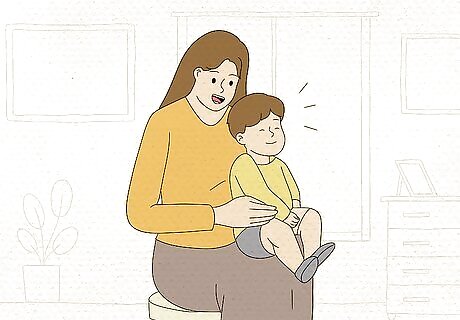
Practice sitting still. Sitting still doesn’t come naturally to most toddlers, but you can practice the skill at home to help strengthen their sense of self-control. To start, have your toddler sit in your lap for one full minute and challenge your kid to sit as still as possible. Gradually lengthen the time until your child can sit for longer stretches without fidgeting. Try not to entertain your toddler too much during these practice sessions—the goal is to get your child to tolerate peaceful stretches of time without entertainment. As your toddler improves at this exercise, you can switch from your lap to a chair. Sit next to your child and continue to challenge them to sit still.

Read aloud to your child. Reading aloud engages your toddler in a quiet, attentive activity, building their ability to focus and sit peacefully. Teach your toddler to pay attention to details—ask questions and point out interesting things in the pictures. Start by choosing your child’s favorite book, or read a short one right before bed, when your toddler is already expected to stay in the same place. You can also try reading to your toddler while they’re in the bath. Before reading, announce to them that it’s “story time” and “time to sit and listen!” You can have them sit on a pillow or soft toddler chair in front of you—this can help your toddler develop self-control and learn that listening comes with specific expectations, like sitting still and paying attention.
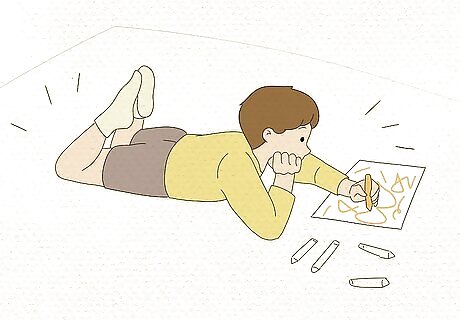
Encourage artistic activities. Make sure your toddler has access to paper, crayons, pencils, and/or paint. These activities are also engaging and encourage a longer attention span. Challenge your child to finish a picture before moving on to something else. At first, it may help to participate in these activities alongside your child. Having your attention may encourage your child to focus on an artistic endeavor for a longer period of time. As they learn to be more focused and attentive, you can begin to sit back and watch.
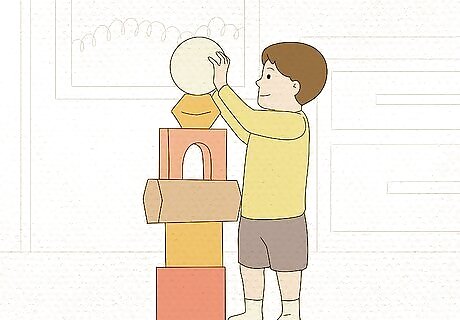
Play games that require quiet attention. Try to get your toddler to play with blocks, puzzles, and other games that don’t involve physical activity. These games can help toddlers develop memory skills, fine motor coordination, and the ability to sit still. You can also point out small or interesting details in your surroundings to help improve your toddler’s attention span.

Build quiet moments into your family’s routines. Choose regular times to sit quietly together as a family, perhaps at the beginning of a meal or at some designated time for quiet reading. If your toddler sees their parents and siblings modeling appropriate activity, they may catch on more quickly. Remember that most toddlers won’t sit still for longer than a couple of minutes. Start by sitting together for 5 minutes, and build up from there when your toddler starts to catch on. Make sure to reward them for good behavior after!
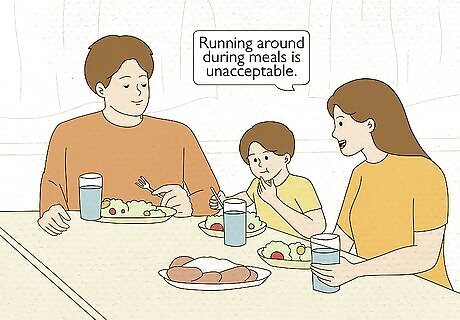
Use mealtimes as practice. Teach young children to sit quietly at the table during meals. Make sure your child understands that running around during meals is unacceptable; they need to sit still and finish eating before getting up to play. Because mealtimes occur so regularly, they offer a great opportunity for practicing your toddler’s skills. Set a good example during mealtimes. When you sit down to have dinner, try not to get up to answer the phone or see what’s on television. Consider letting your child bring a doll or teddy bear to the table as a dining companion and point out that the doll or teddy doesn’t get up or move around at the table.

Reward your child’s efforts. When your toddler does a good job sitting still or paying attention, offer lots of specific praise. Consider offering a small treat—like a piece of chocolate or a trip to the park—for particularly good behavior. Rewarding your child can not only encourage their good behaviors, but it can help increase their self-esteem and improve your relationship with your child.
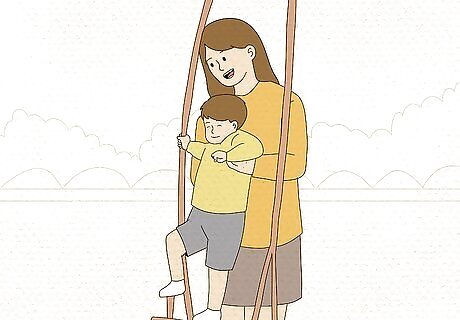
Provide safe ways for your child to get active. Sitting still is a skill that develops slowly over time. Most young children can’t sit still for more than a few minutes at once, and not all children develop at the same rate. Giving your toddler time to get their wiggles out can help them release energy before having to sit still for a period of time. Let your child run, jump, climb, dance, play with toys, or splash around in a bath or shallow pool. 3-year-olds can typically only sit still for 5-10 minutes at a time, while 5-year-olds can only sit for 15 minutes. Be patient, and know that change takes time. If your toddler is engaging in an activity, try to give them lots of opportunities to get up and move around the room so that they can stay focused for longer.
Putting Your Child’s Skills into Practice
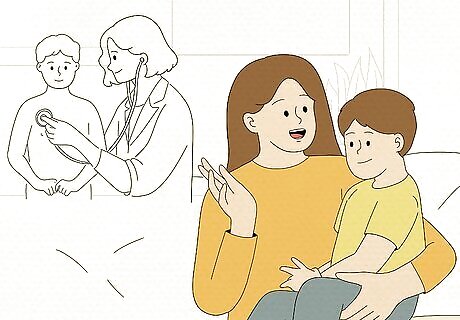
Prepare your child for situations where they have to sit still. If you’re going to be in a situation where your toddler will have to sit still, start preparing early. Let your toddler know what the situation will be and what kind of behavior you expect, and if it’s a long event, plan to take breaks with your toddler so they can let their energy out. Typical situations include: Restaurant meals: Choose family-friendly restaurants, and let your toddler know that they need to sit still and behave. Haircuts: If your toddler wiggles, fidgets, and jumps around, it can be difficult to manage a good haircut. Explain this to your child in advance, and suggest that they sit as still as possible and watch the haircut in the mirror. Medical examinations: Children need to sit still during medical exams, especially for immunizations, blood tests, and other lab work. During the exam, try to occupy your child as best you can. Distract them by pointing out colorful paintings or drawings, and use your imagination—a drop of blood can be a ladybug or raspberry juice. Church, concerts, and theater performances: Your child may not be able to sit still for something as lengthy as a church service or a concert. Plan to take quick breaks, and take your child outside occasionally to burn off some energy.

Make sure your child’s basic needs are met. You can’t expect a hungry, thirsty, exhausted, or otherwise uncomfortable toddler to sit still and behave for a long time, so try not to attempt any event that requires sitting still without feeding your toddler and making sure their other needs are met. Getting the recommended amount of sleep can help your toddler be still and alert. Toddlers that are 1-2 years old should get 11-14 hours of sleep a day, while 3- to 5-year-olds should get 10-13 hours, including naps.
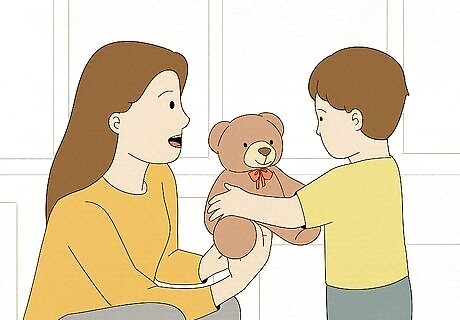
Distract your child. When your child needs to sit still, whether it’s during a meal or at a doctor’s appointment, it helps to offer a distraction. Have your child focus on a painting on the wall, their image in the mirror, a silly song or story—anything that works. If necessary, bring favorite toys, picture books, and snacks. Try giving your toddler a fidget toy. Sensory toys or weighted blankets can distract your toddler, which can help them stay still for longer periods of time. In rare cases, you may want to break out a cartoon or electronic device. This can work when you really need your child to stay still, like at the doctor’s office or barber shop.
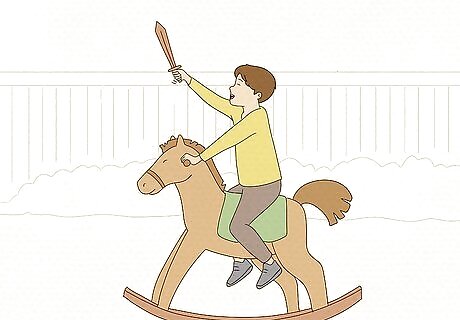
Dress your child to suit the activity. When your toddler is running around, dress them in play clothes and sneakers. When you are doing something that will require “best behavior,” change clothing to reflect your expectations, and encourage your child to recognize the difference. Try not to dress your child in anything too stiff, uncomfortable, or confining—this could make your child more fidgety than ever.

Be an authority figure. Children should play and enjoy a carefree childhood, but you still have to keep things under control. For example, If they disrupt others, try having them take a time-out to calm down or for you to talk about their behavior with them. Be sympathetic, but remember that you set the rules—try not to cave into toddler fury. Be consistent and try to stay unfazed when your toddler tries to push your buttons. If the situation gets overwhelming, step away and take deep breaths to quickly calm down. Pick your battles, and go for positive reinforcement more often than punishments. Praising your child and giving them rewards can help you maintain a great relationship with them while encouraging them to keep up good behavior.

Give your child choices. Even though you’re the authority, you can still give your child some choices. Do they want to sit in your lap or in a chair? Do they want apple slices or cheese cubes for their snack? Permitting your toddler to make decisions will give them a sense of independence and control. For example, if your child is refusing to sit for story time, ask “We’re reading a story tonight, but you can decide what comes first. Do you want to read a story now or do you want to play a game first?” Allow your toddler to choose where or what to use to sit. Instead of making them sit on a hard wood or plastic chair, let them sit on a beanbag. You could also bring a pillow with you for them to sit on during special events.
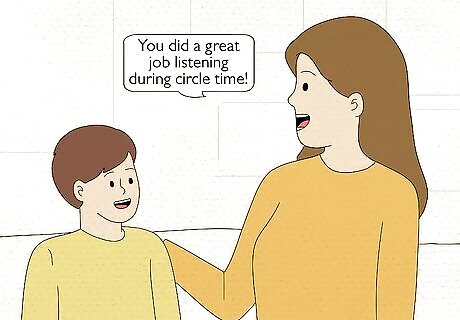
Praise good behavior. Let your toddler know that you are proud when they sit quietly and behave. Make sure your praise is specific so that your child knows what they did well. For example, you could say: “You did a great job listening during circle time!” “That was so good, you didn’t stand up at all during dinner!” “Way to go getting your wiggles out before church!”



















Comments
0 comment